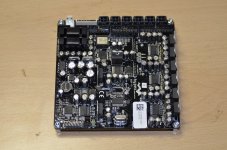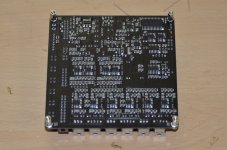The block diagram indicates there is a PGA after the analogue inputs (and before the ADC).
So it can probably be considered as "digitally controlled analogue", when it comes to the analogue inputs that is.
So it can probably be considered as "digitally controlled analogue", when it comes to the analogue inputs that is.
But will it not degrade the soundquality when used on low volume?
You would have to use extreme digital attenuation for it to be noticable, and at that stage the volume is so low so you won't notice it anyway =)
As long as you don't do a large amount of uneccesary digital attenuation only to amplify the signal afterwards you should be fine.
The block diagram indicates there is a PGA after the analogue inputs (and before the ADC).
So it can probably be considered as "digitally controlled analogue", when it comes to the analogue inputs that is.
It maybe possible that PGA stands for programmable gain adjustment, aka the gain jumpers on the board. If I have received mine, I will check this!
Using digital level control before the DAC as a volume gives a degraded sound at low volumes, on my experience. A digitally controlled analog attenuator is a requisite for that purpose.You would have to use extreme digital attenuation for it to be noticable, and at that stage the volume is so low so you won't notice it anyway =)
Digital attenuation works ok to equalize drivers efficiencies +amplifiers gain disparities.
if you can notice a well designed modern digital volume control at even low normal listening levels, your gain structure is all wrong
Turning down the volume is equivalent to listen to a pianissimo passage, where the volume will be low anyway - maybe just using 6 out of 16 bits of data on the CD. Now do the sound quality suffer during a pianissimo? I think not.
If the gain structure is all wrong, the sound suffers at any level.
If the gain structure is all wrong, the sound suffers at any level.
hmm I cant work out if you are agreeing with me or not. maybe just misunderstood my post.
what I mean is; if you have to turn the digital volume down to a point where it is noticeably effecting the sound quality, your gain structure is wrong, because you shouldnt be needing to turn it down that much, if you do have to, you have too much gain.
most digital volume controls will be operating at 32/48/64 bit floating point and depending on the dac, in the 32bit ESS its simply part of the dac, not a chance I will ever turn down the volume till there is 6 bits
what I mean is; if you have to turn the digital volume down to a point where it is noticeably effecting the sound quality, your gain structure is wrong, because you shouldnt be needing to turn it down that much, if you do have to, you have too much gain.
most digital volume controls will be operating at 32/48/64 bit floating point and depending on the dac, in the 32bit ESS its simply part of the dac, not a chance I will ever turn down the volume till there is 6 bits
I have one question for Hypex, and that is regarding the output level. The manual says 2.59 V. Is that adjustable in any way on the analog side?
hope so, since that would send an ncore into clipping
Fair enough - but some of us have already have had to modify the feedback gain of our ncores to cope with "pro" line levels, and prefer to use that kind of levels.
No PGA chip, so pga means the gain jumpers.
Thanks, good to know! 😉
Give us some pics now.. 😛
Fair enough - but some of us have already have had to modify the feedback gain of our ncores to cope with "pro" line levels, and prefer to use that kind of levels.
You have a DLCP connected directly to your Ncore modules?
The voltage gain of the Ncore is 26db (which seems an excellent nominal gain.)
It seems to me an easier "fix" would be to install a dedicated, fixed attenuator between your DLCP and Ncore(s) such that DLCP minimal attenuation settings are near your nominal listening levels.
Cheers,
Dave.
You have a DLCP connected directly to your Ncore modules?
Not yet - right now I have a Behringer DCX2496 driving the ncores, but aiming to replace it with the DCLP - just got shipping acknowledgement.
The voltage gain of the Ncore is 26db (which seems an excellent nominal gain.)
Not sure what's so excellent about it, as 16 or 36 dB is just as good as 26, as long as the overall gain structure of your system makes sense.
It seems to me an easier "fix" would be to install a dedicated, fixed attenuator between your DLCP and Ncore(s) such that DLCP minimal attenuation settings are near your nominal listening levels.
Easier, yes, but not better. It is never a very good idea to over-amplify and then have to attenuate. Ideally you have just enough amplification in your whole chain to give full output with full-scale input. The nice thing about a digital source is that you know for sure what the highest possible input amplitude will be.
I think the people at Hypex will not be that stupid to get the interfacing with their own amps wrong!
Plus 1.I think the people at Hypex will not be that stupid to get the interfacing with their own amps wrong!
Can anyone with more knowledge then me comment the strange samplingrate?
DSP sampling rate Fs 93.75 kHz
ADC sampling rate Fs 93.75 kHz
I think the people at Hypex will not be that stupid to get the interfacing with their own amps wrong!
Of course not. The output voltage range of the DLCP is great for an unmodified ncore. It's just that some pro gear is even "hotter", and some of us have modified the gain of the ncores to cope with that. Our bad.
Can anyone with more knowledge then me comment the strange samplingrate?
My guess would be that it is easily derived from a popular crystal frequency, and on purpose lower than 96 K to ensure you never get a buffer under-run when fed with 96/192 material.
- Home
- Source & Line
- Digital Line Level
- Hypex DSP module(s)


